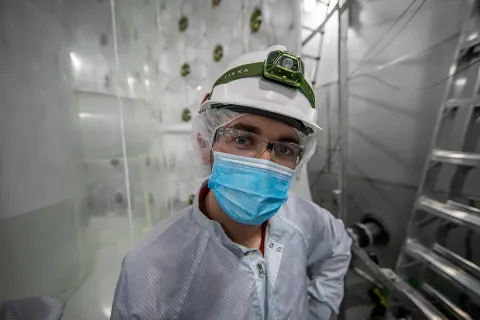Explore the dark between the stars at Neutrino Day
Dark matter researcher Hugh Lippincott will discuss dark matter’s connection to the stars at Neutrino Day: Star Chronicles
Between the billions of stars and galaxies, some areas of space seem rather… empty. Lightyears stretch between galaxies. Stars burn in vast, uncluttered swaths of space. Researchers believe, however, that the dark expanses of space are permeated with unseen particles called dark matter.
At Neutrino Day: Star Chronicles, researcher Hugh Lippincott will discuss dark matter during in his talk, “The Dark between the Stars”, on Saturday, July 10 from 11 a.m. to noon MT.
Lippincott is the spokesperson for LUX-ZEPLIN (LZ), a dark matter experiment located on the 4850 Level of Sanford Underground Research Facility (SURF), and an assistant professor of physics at the University of California, Santa Barbara.
“Dark matter is the glue that made structures like the Milky Way come together as the universe evolved,” said Lippincott. “We wouldn't be here without dark matter. Our galaxy would not have formed. There would be no clustering. There would be no structure. We would see no stars at night if there hadn't been dark matter.”
Likewise, if it weren’t for stars, researchers probably wouldn’t be on the hunt for dark matter. That’s because strong evidence for the existence of dark matter comes from observations of stars—how distant starlight bends as it travels toward Earth and how stars’ orbits are faster than originally predicted.
While researchers estimate the stuff accounts for about 85 percent of the matter in the universe, they have yet to directly detect dark matter particles. Lippincott has been a part of several attempts to pin down these elusive particles, looking for their tracks in bubble chambers, liquid argon detectors and, most recently, in LZ, a liquid xenon detector a mile underground at SURF.

An international collaboration of 250 scientists and engineers from 37 institutions, LZ is dialing up the search for dark matter. The experiment is anticipated to be the world’s most sensitive dark matter detector when it begins taking data later this year.
During Neutrino Day, Lippincott will explore the clues stars reveal about dark matter, the difficulty of completing a rare event search and how LZ will take the search for dark matter further than ever before.
Attend this live talk in our virtual Black Hills Energy Main Stage in Gather.town or live on Facebook, Vimeo, YouTube and www.neutrinoday.com.
